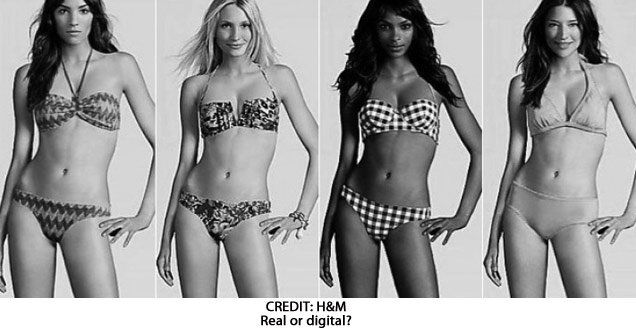Health, Body and Fitness: Killing us digitally

Swedish clothing franchise H&M has admitted to using computer- generated models to showcase their clothing. The wellknown clothing company designs a body that can better display clothes made for humans than humans can, then "dresses" it by drawing on its clothes. Graphic designers digitally paste the heads of real women onto the bodies in post-production.
For now — and in the future — even professional models' faces won't be considered perfect enough for fashion. In the digital world, we can not only photoshop a human body, but we can now change their skin colour — at least our fictional digitally enhanced world is diverse.
In the film Killing Us Softly, Jean Kilbourne discusses how the image of women has changed in advertising. In the beginning of the film, Kilbourne says that advertisements send a clear message about what it means to be a woman — the same message produced 20 years ago can be found in today's society as well. Kilbourne claims that advertising gives a sense of power to women, but this power trip is unfulfilling and short lived. The H&M controversy only supports this theory, as it sends the message to women that they just aren't good enough.
The average North American spends three years of his or her life watching television commercials, and views approximately 3,000 advertisements every day. In a world where we take our values, attitudes and perceptions of love, intimacy and body image — knowingly or not — from advertisements, how do we now define what is normal?
Are the new digitally enhanced models of H&M an expected step advertising is taking in our normal world? Kilbourne makes her thoughts more than clear in the film: advertising tells us who we are and who we should be. The message from the H&M advertisements is clearer than ever: not even the thin, tall, fit, beautiful fashion models are good enough anymore. The message to women and young girls is that they should continue to strive for perfection, but also that this image is unrealistic.
What message does this send to the average woman today? That she is trying to attain the unattainable. As Kilbourne stated, "Failure is inevitable." The ideal woman is based on absolute flawlessness. "She never has any lines or wrinkles; she certainly has no scars or blemishes; indeed she has no pores."
Although many individuals are only learning of the deception they view in advertisements now, digitally created models are nothing new. In the 1980s, one popular advertisement showed a woman's face that was made up of several parts of different women's faces. As the standard for beauty continues to rise, the most important thing women can do is to be aware of what they are watching and reading.
The backlash from many women and feminists toward H&M has been found in the news and on many social media sites. If you have something to say about the unrealistic expectations and body images being represented by the company, you can join the conversation on Twitter: @hm or on Facebook: the H&M Page.













